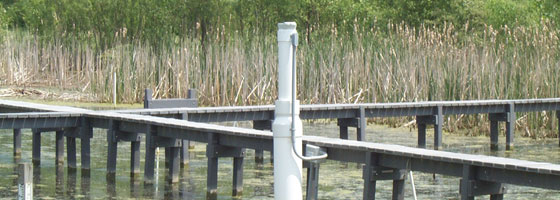University research park seeks to understand fragile wetlands

It’s been likened to putting together an enormous jigsaw puzzle. Or trying to glue a broken vase back together. Perhaps most vividly, “It’s like taking a hamburger and trying to put it back on a cow,” as University of Wisconsin ecologist Joy Zedler described wetland restorations many years ago.
These metaphors all make the point that restoring or recreating the world’s fragile wetlands is a much more daunting task than preserving them in the first place. However, in many cases, there no longer exists the luxury of the latter.
Since 1900, more than half of the world’s wetlands have vanished, mostly because of drainage and human development efforts.
Wetlands are vital natural filters for water, removing nitrogen, phosphorus, and carbon, and they serve important water removal and retention functions. They also provide a diverse habitat for fish, wildlife, plant life, waterfowl, waterbirds, shorebirds, and songbirds.
Recognizing the immense value of wetlands and the need to preserve them, scientists at The Ohio State University’s Olentangy River Wetland Research Park are leading an effort to understand how wetlands function.
Researchers at the wetland park hope the data gathered will help determine how to restore damaged wetlands as well as create new ones.
This is a particularly pressing concern in Ohio, which has lost more than 90 percent of its wetlands in the last 200 years, according to the U.S. Geological Survey. The state’s wetlands have shrunk from about 5 million acres to less than 500,000. In fact, Ohio’s wetlands have experienced the worst diminishment compared to any other state.
The Olentangy River is a tributary of the Scioto River in Ohio. It is positioned within a 30-minute drive for more than 1.5 million Ohio residents. Despite rapid housing and business development around the Columbus area, the Olentangy River has actually seen an improvement in water quality, as it was upgraded to an exceptional warm water habitat by the Ohio Environmental Protection Agency.
Constructed 20 years ago from abandoned land, the 50-acre wetland park draws water from the Olentangy and features thousands of feet of boardwalk that offer students and researchers access without disruption to the marsh. A deep-water billabong marsh and a bottomland forest also border the Olentangy River.
Finally, the park harbors two constructed 2.5-acre marshes with a river water delivery system, one that was artificially planted with wetland vegetation in 1994 and the other left to colonize naturally.
Interestingly, recent data from the park reveals that both wetlands, despite their disparate beginnings, now have equally diverse plant life and are equally effective at retaining contaminants.
To aid in the park’s mission to understand and preserve wetlands, the Heffner Wetland Research and Education Building was built in 2002. During construction, three additional wetlands were created nearby, including one that receives and retains stormwater runoff from the building.
The facility is managed and operated by wetland scientist Dr. William Mitsch. Researchers studying the park’s wetlands have benefited from a wealth of real-time data collected at various locations.
Mitsch and his staff have worked closely with NexSens Technology over the years to design and install the wetland monitoring system, which utilizes multiple instruments from numerous vendors to provide comprehensive data on conditions in the wetlands.
The requirements for the system included water level, quality, and flow monitoring at strategic locations throughout the wetland research park; a real-time connection to the monitoring devices; and software to manage the data.
To monitor water quality, the team installed several YSI 6600 multi-parameter sondes, which can be deployed for weeks without recalibration. The sondes measure a variety of water parameters, including temperature, conductivity, pH, ORP, dissolved oxygen, turbidity, and chlorophyll.
NexSens AccuStage sensors were selected for water level monitoring. The AccuStage is a self-contained pressure transducer that provides high performance and accuracy over a wide range of operating conditions.
NexSens data loggers with real-time spread-spectrum radio telemetry transmit data from the environmental sensors to a PC in the research building.
Mitsch said the most beneficial aspect of the NexSens real-time monitoring network is the ability to monitor live data from within the facility.
“It is the ecological analog of seeing the score of a game as it is happening as opposed to reading about it the next day,” he said.
In the research building, a computer running NexSens iChart software saves the data and displays current conditions from around the wetlands on large HDTV displays, which Mitsch said are viewed by thousands of visitors annually.
The real-time system also allows for rapid response to sudden changes in conditions in the wetlands.
“We know immediately if there are interesting hydrologic, chemical, or biological events, such as floods, clogged outflows, or pollution,” he said. “Then we can alert our research or management team to take adaptive action.”
Since the wetland research facility is considered the only one of its kind, a key objective is to share the data gathered on wetland science and ecological engineering with experts worldwide.
The wetland park is continuing to pursue collaborative projects both throughout the state and across the globe. To assist with the dissemination of data, iChart automatically produces reports and posts them to a page on OSU’s website. The page gives researchers anywhere access to recent sensor readings, helping advance crucial research on how to maintain, restore, and rebuild the world’s wetlands.




0 comments